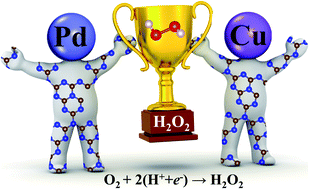Hydrogen peroxide electrochemical synthesis on hybrid double-atom (Pd–Cu) doped N vacancy g-C3N4: a novel design strategy for electrocatalyst screening†
Abstract
The electrochemical oxygen reduction reaction (ORR) to afford hydrogen peroxide (H2O2) provides an alternative to the traditional anthraquinone oxidation process. A major obstacle for this reaction is designing two-electron (2e−) ORR catalysts with high activity and selectivity. Combining the advantages of alloy catalysts and single-atom catalysts, hybrid double-atom catalysts (HDACs) are bringing new opportunities as highly efficient 2e− ORR catalysts. Herein, we developed a novel thermodynamic screening strategy based on oxygen and hydrogen proton adsorptions by density functional theory calculation. In accordance with theoretical predictions, Pd and Cu were screened out from 25 specimens as active centers. And a catalyst of N vacancy g-C3N4 doped with Pd–Cu hybrid double atoms (PdCu@V_C3N4) was designed. The Sabatier method illustrates that PdCu@V_C3N4 is located at the top of the 2e− ORR volcano plot with an extremely low overpotential of 0.02 V. Furthermore, the dynamic rate-determining step is OOH* intermediate formation with a dynamic activation barrier of 0.64 eV. The high selectivity and activity of PdCu@V_C3N4 are attributed to end-on O2 adsorption configuration by “slope” geometric construction and electronic regulation of neighboring hybrid atoms. Our work predicts potential HDACs for future experiments, and also provides a general method for the quick screening and design of highly efficient H2O2 catalysts.



 Please wait while we load your content...
Please wait while we load your content...